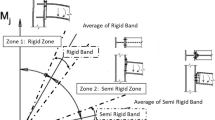Abstract
The classic methods of structural design based on trial-and-error are generally highly iterative and computationally intensive, especially in a tall building consisting of thousands of structural members. This paper presents a closed-form solution for a minimum weight design problem which may be used at the early-stage design of a high-rise and slender structure. Before considering the weight-based problem, an intervening optimization formulation is introduced in advance which for a fixed amount of material presents an optimal pattern for its distribution. The obtained pattern is then used in the main problem, in which the total weight is considered as the objective function while satisfying the peak lateral deflection constraint and some practical requirements. The flexural stiffness in its general form is selected here as the design variable, so the proposed method is not restricted to a particular system, and any structural system may be addressed. A braced-tube 61-storey building example is presented to be designed based on the proposed technique to illustrate the effectiveness and practicality of the method.







Similar content being viewed by others
References
Alavi A, Rahgozar R, Torkzadeh P, Hajabasi MA (2017) Optimal design of high-rise buildings with respect to fundamental eigenfrequency. Int J Adv Struct Eng 9(4):365–374
Aldwaik M, Adeli H (2014) Advances in optimization of high-rise building structures. Struct Multidiscip Optim 50(6):899–919
Connor JJ, Pouangare C (1991) Simple model for design of framed-tube structures. J Struct Eng 117(12):3623–3644
Kwan A (1994) Simple method for approximate analysis of framed tube structures. J Struct Eng 120(4):1221–1239
Rahgozar R, Ahmadi A, Sharifi Y (2010) A simple mathematical model for approximate analysis of tall buildings. Appl Math Model 34(9):2437–2451
Rahgozar R, Malekinejad M (2012) A simple analytic method for computing the natural frequencies and mode shapes of tall buildings. Appl Math Model 36(8):3419–3432
Malekinejad M, Rahgozar R (2014) An analytical model for dynamic response analysis of tubular tall buildings. Struct Des Tall Spec Build 23(1):67–80
Rahgozar R, Ahmadi AR, Ghelichi M, Goudarzi Y, Malekinejad M, Rahgozar P (2014) Parametric stress distribution and displacement functions for tall buildings under lateral loads. Struct Des Tall Spec Build 23(1):22–41
Rahgozar R, Mahmoudzadeh Z, Malekinejad M, Rahgozar P (2015) Dynamic analysis of combined system of framed tube and shear walls by Galerkin method using B-spline functions. Struct Des Tall Spec Build 24(8):591–606
Malekinejad M, Rahgozar R, Malekinejad A, Rahgozar P (2016) A continuous–discrete approach for evaluation of natural frequencies and mode shapes of high-rise buildings. Int J Adv Struct Eng 8(3):269–280
Moon KS, Connor J, Fernandez J (2007) Diagrid structural systems for tall buildings: characteristics and methodology for preliminary design. Struct Des Tall Spec Build 16(2):205–230
Liu C, Ma K (2017) Calculation model of the lateral stiffness of high-rise diagrid tube structures based on the modular method. Struct Des Tall Spec Build 26(4):e1333
Montuori GM, Mele E, Brandonisio G, Luca AD (2014) Design criteria for diagrid tall buildings: Stiffness versus strength. Struct Des Tall Spec Build 23(17):1294–1314
Moon KS (2010) Stiffness-based design methodology for steel braced tube structures: a sustainable approach. Eng Struct 32(10):3163–3170
Chan C, Huang M, Kwok K (2010) Integrated wind load analysis and stiffness optimization of tall buildings with 3D modes. Eng Struct 32(5):1252–1261
Stromberg LL, Beghini A, Baker WF, Paulino G (2011) Application of layout and topology optimization using pattern gradation for the conceptual design of buildings. Struct Multidiscip Optim 43(2):165–180
Christensen PW, Klarbring A (2009) An introduction to structural optimization. Springer Science, Business Media B.V., Berlin
SAP2000 (2013) Ultimate 16.0.0, structural analysis program. Computer and Structures Inc., Berkeley
Funding
No funding information available.
Author information
Authors and Affiliations
Corresponding author
Rights and permissions
About this article
Cite this article
Alavi, A., Rahgozar, R. A Simple Mathematical Method for Optimal Preliminary Design of Tall Buildings with Peak Lateral Deflection Constraint. Int J Civ Eng 17, 999–1006 (2019). https://doi.org/10.1007/s40999-018-0349-1
Received:
Accepted:
Published:
Issue Date:
DOI: https://doi.org/10.1007/s40999-018-0349-1




